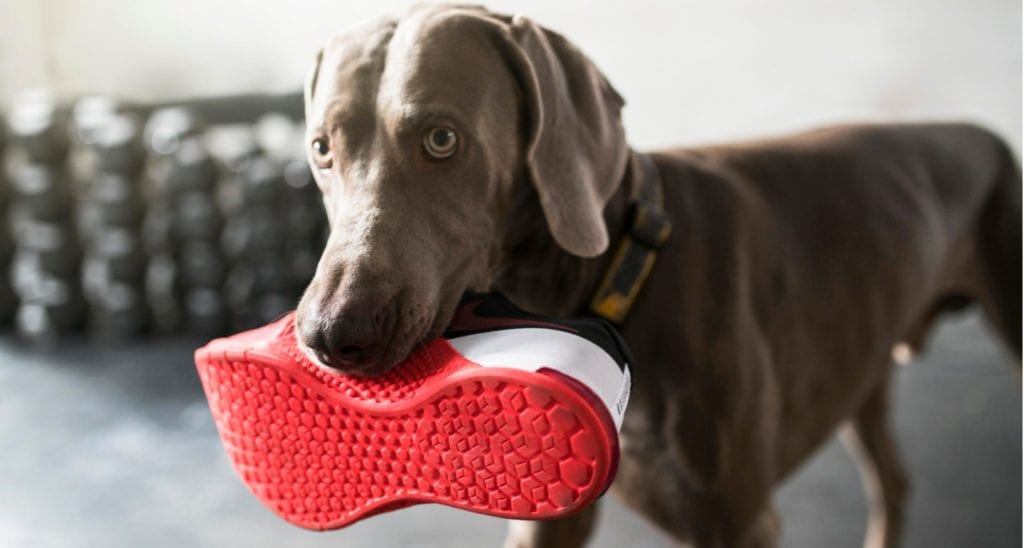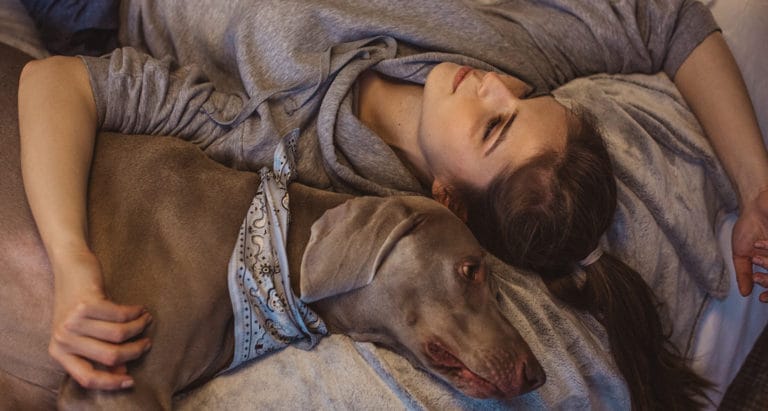Is your dog stealing? Dogs who turn to a life of crime stealing household objects can range from teething pups to bored adults. Reforming a canine robber requires that you first determine the motivation behind the crime and then formulate a plan to prevent future heists.
If your dog is a common criminal, you’ll need to invest more time to help him walk the straight and narrow. For the small-time thief, a little creativity and planning might be all your furry burglar needs to change his ways.
Why Dogs Steal
One of the main reasons many dogs resort to a life of crime is because they’re bored. Without enough appropriate outlets to burn off energy, these pups are left to find entertainment on their own, which often comes in the form of chomping on contraband.
Most poaching pooches fall into one of the following categories:
- Stealth Stealer: These dogs wait until the coast is clear before silently making off with their treasures. Whether it’s leftovers on the counter or a sock that missed the laundry basket, these thieves grab and go before anyone has a clue.
- Attention Seekers: On the opposite end of the spectrum are dogs who want you to know they’ve nabbed contraband. They snag the dishrag and proudly parade by you, hoping you notice their handiwork.
- Catch-Me-If-You-Can: Related to the attention-seeking thief, these speedy criminals are in it for the thrill of the chase. They steal things like shoes and garbage in the hopes that you’re up for a round of hot pursuit, knowing that their four legs usually trump your two.
- The Collector: Some dogs enjoy acquiring treasures and stockpile their goodies in secret spots. These predictable pups typically have favorite items to take, like underwear and towels, along with their own stash of toys.
Boredom isn’t the only reason a dog may steal. For example, for dogs who steal food, the tempting smells and access to food is all the motivation they need. That includes leftovers on the counter or in the garbage can, as well as stinky non-food items like socks, underwear, diapers and other unmentionables.
Puppies, on the other hand, might steal things because they’re teething, and they don’t have adequate options to chew on. If your puppy isn’t interested in the rubber bones you give him, he’ll find something else that takes the edge off his need to gnaw.
Note: Dog stealing is never for “retribution” or because your pooch is trying to “get back at you.” While dogs are capable of complex emotions, your pet isn’t able to reason that taking your shoe is adequate payback for leaving him alone to run an errand.
What to Do if You Catch Your Dog Stealing
Your dog probably is faster than you are, so trying to reclaim stolen property by chasing likely won’t work. In fact, it might even teach your pup to grab stuff when he’s bored to get your attention. Though it feels counterintuitive, ignore your thieving dog if he takes a low-value item—provided he doesn’t try to destroy or swallow it.
Attention-seeking and catch-me-if-you-can dogs want you to chase them, so ignoring them takes the fun out of the game. Instead, exit the room. Your dog likely will drop the item and trot after you.
In circumstances where you must immediately retrieve an item, teaching your canine to trade or drop an object helps. An easy way to begin this dog training it is to incorporate the “drop it” cue into play. Try the steps below:
- When your dog has a toy or ball in his mouth, place a treat in front of his nose. He’ll likely drop the toy to grab the treat.
- As your dog opens his mouth, say the word “drop” as a command, and then give him the treat.
- Repeat this step several times until your dog is dropping the item quickly, then try a repetition with the treat hidden in your pocket and ask your dog to “drop.”
Always give your dog a treat after he drops the item so he understands that dropping items, no matter what they are, is highly rewarding. Continue practicing with several temptations so your pup starts to generalize the behavior and eventually is able to relinquish valuable contraband.
- If you haven’t had a chance to perfect your drop cue and your dog grabs something that you need to recover immediately, like medication or a paycheck, try an emergency trade. See below:
- Run to the cupboard where you keep your dog’s food or to the refrigerator and take out treats or cheese in a crinkly wrapper.
- Get down on your knees and place a few bites of food in the ground in front of you so your dog comes close.
- He’ll likely drop the item to eat the food, at which point you can gently reclaim what he snagged.
While training your dog not to steal, it helps to also take measures to prevent your pooch from stealing in the first place.
Shop Related Products on Chewy
How to Prevent Your Dog from Stealing in the First Place
A straightforward way to prevent canine thievery is to manage your dog’s environment. Here are ways to keep canine robbers at bay:
Keep your kitchen free of food within your dog’s reach.
This is especially useful for dogs who love stealing food. If your pup “counter surfs” to snag food left on a table, the easiest way to prevent him from stealing is to keep your kitchen free of edible temptations that are within his reach. Remember that creative doggos can manage to snatch items that you considered out of reach!
If this is not possible, shut doors or use baby gates to prevent your pup from being in the kitchen unsupervised.
Learn how to stop your dog from counter surfing for good.
Increase your dog’s workout plan.
Include more physical and mental exertion in your pup’s day to decrease his need to entertain himself by stealing. Aim for pant-inducing activities, such as longer walks, and creative activities that tax his brain, like hide-and-seek.
Puppy-proof your house.
Even if you think he’s past the stage, clean up anything that could be a target on the floor, like shoes; put away tempting dangling items, like low-hanging towels; secure garbage can lids and keep bedroom doors closed. Get tips for puppy-proofing the bathroom.
If your teething pup manages to find something, make sure to give him an appropriate chewing item after he relinquishes whatever he grabbed. Learn what to expect with a teething puppy.
Give your dog plenty of busy toys designed to keep him occupied.
Most dogs enjoy playing with hard rubber toys that dispense treats, like West Paw’s Zogoflex Tux toy. Treat-stuffed activity toys can help teach your dog that his stuff is much more fun than yours!
As always, training requires patience. If you continue to encounter stealing issues with your pup after taking the time to follow the instructions above, it might be wise to see a dog behaviorist or trainer.
Share:










